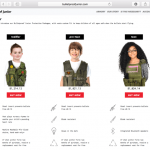These Are The Best (And Worst) Places Around The World For Kids To Grow Up
By Ben Paynter , May 31, 2017
Kids who grow up in particularly impoverished, discriminatory, and conflict-ridden places may die early or see their own chances of success drastically reduced because of preventable health issues, malnutrition, poor schools, violent home lives, or early pregnancy. It’s an issue that affects 1 in 4 youngsters worldwide. Such problems often exist in developing countries, but they’re also largely present with the United States, which came in 36th out of 172 counties audited in Stolen Childhoods, a new report from Save The Children, a nonprofit working to improve young lives.
In honor of International Children’s Day, Save The Children has released that report alongside a YouTube video entitled “Biggest Unboxing Surprise EVER!!” that approximates the confusion and concern that kids must feel as they’re forced into scarier, often abbreviated adult lives. The title may not explain much, but that’s the point. The ad campaign is meant to start out normal, a kid-centric version of the “unboxing” craze. To that end, the video features three kids, two boys and a girl, who receive what appears at first glance to be either a gigantic toy gun (the “Supershooter”), construction kit (“City Builder Set”), or doll (“My Baby Doll”). Things go south when the open the boxes, which are filled with a real ammunition belt, a pickaxe and some rubble, and a positive pregnancy test instead.
The not-so-subtle message, which those same kids drive home by reading from a sheet of statistics in lieu of instructions, reminds viewers that children in poverty may be all too readily encountering these things instead: One in 80 kids are driven from their homes because of conflict and war, while 168 million are forced to work. On average, there is also an underage girl giving birth to her own child once every two seconds.
“We’re trying to build awareness obviously, but we also are trying to drive action,” says Carolyn Miles, the president and CEO of Save The Children, noting viewers can share the video and report, donate to her group directly, or sign a petition the nonprofit plans to submit to various governments to increase investment in children’s issues.
To compare progress among countries, Save The Children’s End Of Childhood Index ranks each place’s livability by eight factors: underage mortality, malnutrition rates, educational opportunity, forced labor, teenage pregnancy, child marriage, conflict displacement, and child homicide.
The best places turned out to be those with lots of governmental investment in health care and education like Norway, Slovenia, Finland, and the Netherlands. The worst are those that have been continually impoverished, and war-torn, with often-neglected rural communities including Niger, Angola, Mali, and the Central African Republic. Lack of universal health coverage, inadequate diets, and unsafe water put the most disadvantaged children at the highest risk of death,” notes the report. About one-third of childhood deaths occur within the first week of birth because of complications mixed with inadequate medical aid. Young kids also die at double the rate of their peers if they live in a conflict zone.

The United States has its own issues. More than 23,000 babies still die at less than a year old, with over 540,000 growing up with food insecurity, and another 750,000 dropping out before finishing high school. There are also thousands of kids who are murdered or commit suicide–and more than a hundred thousand underage births annually, which continue a cycle of poverty in some places. Those states that that are the best for kids include New Hampshire, Massachusetts, New Jersey and Vermont, while those with the worst conditions are Louisiana, Mississippi, New Mexico, and Oklahoma.
Many of these issues hinge on unequal access to resources, particularly in rural areas. Infant mortality numbers, for instance, are linked closely with each community’s level of affluence. (Mississippi fares the worst, losing 9 children per 1,000 born there.) There’s a similar correlation with food insecurity and child-harming violence.
Save The Children, which is already active in 16 states, would like to see Congress fund more early childhood education programs, home-based maternal support and childhood care visits, and after-school programs, all of which improve education and medical access while allowing parents to continue working so they can improve their own standard of living. “Our call is to invest in children [globally],” Miles adds. “But I think it’s particularly important right now for Americans to think about how we invest in our poorest neighborhoods and communities.”
“What the world is going to be like about 15 years from now depends on what happens for these kids now,” she adds. “And so our message is we really need to invest in our children whether we’re talking about children here in the United States or whether we’re talking about children around the world.” Read the report and take action here.
The U.S. doesn’t rank very high–because other countries governments actually invest in keeping their kids healthy and safe.
Kids who grow up in particularly impoverished, discriminatory, and conflict-ridden places may die early or see their own chances of success drastically reduced because of preventable health issues, malnutrition, poor schools, violent home lives, or early pregnancy. It’s an issue that affects 1 in 4 youngsters worldwide. Such problems often exist in developing countries, but they’re also largely present with the United States, which came in 36th out of 172 counties audited in Stolen Childhoods, a new report from Save The Children, a nonprofit working to improve young lives.
Fast Company , Read Full Story
(21)














